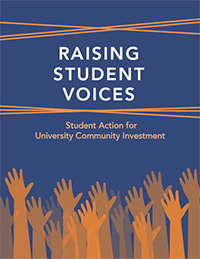Grantee Spotlight: Mercer University Partners to Revitalize Beall’s Hill Neighborhood
University of Massachusetts Creates More than Jobs through the Wellspring Collaborative
Universities Investing in Their Communities: Student- and Administration-Led Approaches
How to Make Place Matter
Universities Investing in Their Communities: Student- and Administration-Led Approaches
According to a recent report by the Democracy Collaborative and the Responsible Endowments Coalition, colleges and universities could be doing more to improve their communities. In “Raising Student Voices: Student Action for University Community Investment,” authors Joe Guinan, Sarah McKinley, and Benzamin Yi, quoting from the 2011 Green Report Card from the Sustainable Endowments Institute, note that only “[s]ixteen percent of schools currently have endowment investments in community development loan funds or similar investment opportunities” (p. 17).

Joe Guinan, Sarah McKinley, and Benzamin Yi of the Democracy Collaborative and the Responsible Endowments Coalition provide recommendations for improving university-based community investing in their report “Raising Student Voices: Student Action for University Community Investment.”
The report defines community investment as “directing financial resources into the local community in a way that empowers low-income residents, small businesses, and sustainable economic development” (p. 8). These investments are often made through a community development financial institution (CDFI) such as a community bank, community development credit union, venture capital fund, or loan fund. In addition, CDFIs give residents a voice in deciding which investments should be made in their communities. By investing in CDFIs, colleges and universities can help construct affordable housing, create small businesses, and develop community facilities that benefit both the community and the institution.
Despite their long tradition of community engagement, many colleges and universities have yet to invest a substantial amount of their operating funds and endowments in their communities. Although these institutions’ endowments collectively are worth around $400 billion (their annual operating budgets represent a similar amount), only a small percentage of this capital is devoted to community investment. The report identifies two models that institutions of higher learning use when investing in their communities. The first model, administration-led initiatives, occurs when school administrators, trustees, and professors invest to generate the most funds possible for their endowments, whereas the second, student-led initiatives, occurs when student activists demand that the college invest in their community. After stressing the importance of the latter, the report argues that these institutions can drive sustainable community economic development. Establishing partnerships with students and residents is critical to ensuring that a university’s investments address the community’s needs and interests.
Case Studies of Community Investment Initiatives
Based on interviews with students, administrators, faculty, and community members, the report presents six case studies of administration-led and student-led community investment initiatives, highlighting the benefits and drawbacks of each investment model. The authors found that one benefit of administration-led community investment initiatives is that the scale and longevity of the investments expand greatly when university leaders become involved, largely because these leaders have the authority to form new offices and staff positions to administer these investments. For example, Duke University’s $12 million investment in the Latino Community Credit Union and Self-Help Credit Union led to the construction of affordable housing in Durham, North Carolina. One of the drawbacks of this top-down model is that investments are usually conservative to ensure immediate returns and do not always reflect the community’s interests.
Student-led community investment campaigns are effective at keeping community issues at the forefront of discussions about a university’s investment practices. By bringing attention to these issues, students and the general public can pressure colleges to invest in the local community. The authors note that the University of Chicago’s $1 million investment in four CDFIs in Chicago’s South Side is one example of a successful student-organized community investment campaign. But this bottom-up model has its drawbacks. For example, students typically can get the administration to commit only to investments that are limited in scale. Other factors that reduce the effectiveness of these initiatives are high student turnover rates, the difficulty of organizing a wide network of dedicated students and community members, and university leaders who are reluctant to commit to these investments.
Recommendations
Based on the six case studies, the authors recommend blending these two community investment models. A new model in which students initiate the conversation, administrators implement the investments, and community members hold the university accountable for these investments over time could potentially be successful. The report also discusses ways to improve community investment campaigns initiated by students and university administrators. Some of the recommendations include increasing alumni participation in student campaigns, expanding partnerships with community organizations and higher education networks, and developing a financial design that uses university endowments to scale up sustainable community investments. In addition, the report discusses five universities where this hybrid model could be implemented — and raises some challenges they may face — because the universities’ mission, leadership, or student body supports community engagement. The authors stress that, for any blended community investment initiatives to be successful, colleges must build strong ties with community groups and organizations. University administrators, professors, and students must continually ask themselves whether the school’s investments address the real needs of the community and whether they will improve residents’ lives.


